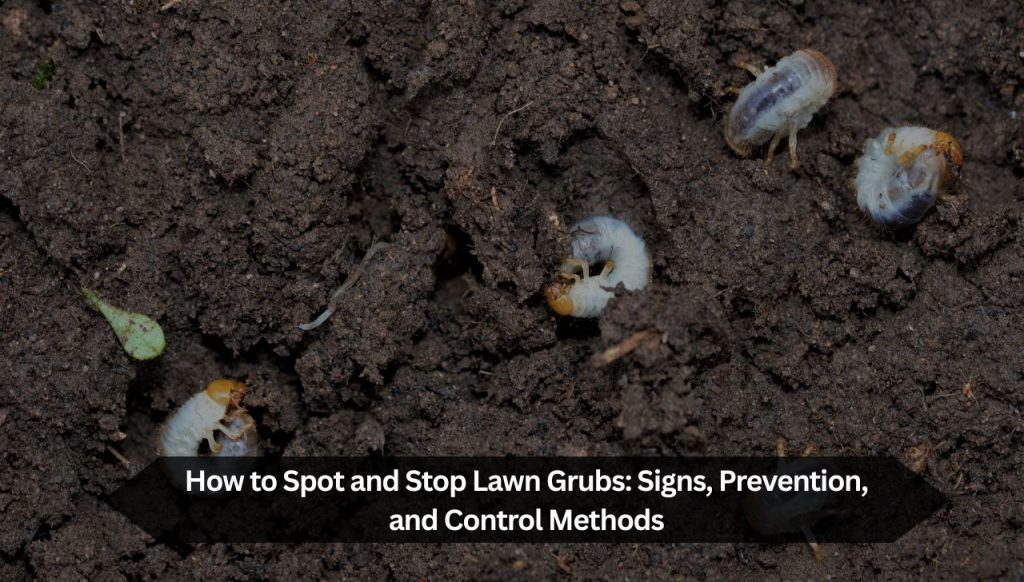Ever seen brown patches on your lawn that seem to spread for no reason? Or maybe birds have been pecking at your yard like it’s a buffet. Chances are, you’ve got grubs.
Grubs are sneaky. They live underground, eating your lawn from the roots up. You won’t always see them, but they leave signs. If you catch them early, you can stop the damage. But wait too long, and your grass might not bounce back. Let’s look at what grubs are, how to spot them, and what to do about them—naturally or with treatments.
What Are Grubs?
Grubs are beetle larvae. That means they’re baby beetles before they grow wings. Most often, they come from Japanese beetles, June bugs, or chafer beetles.
They live under the soil and feed on grass roots. They’re small, white, and C-shaped. If you dig a few inches into your lawn and find one, you’ll know it. They look soft and plump, with brown heads.
Grubs don’t bite people or pets. But to grass? They’re a nightmare.
Discover More : Mushrooms In Lawn: Causes, Risks, and How to Manage Them
Signs of a Grub Infestation
Grubs don’t announce their arrival. You have to look for clues.
Here are common signs:
- Brown Patches: These show up even when you’re watering regularly.
- Soft, Spongy Ground: The soil may feel loose or lift up like a carpet. That’s because the roots are gone.
- Animal Activity: Birds, skunks, raccoons, and moles love grubs. If they’re tearing up your yard, they’re probably hunting.
- Wilting Grass: Even with good moisture, parts of your lawn might wilt or die.
- Grub Count: Dig a square foot of soil about 2–4 inches deep. If you find more than 5–10 grubs, it’s a problem.
Don’t wait for all the signs. Catching grubs early means less damage and easier treatment.
Why Grubs Are Harmful to Your Lawn
Grubs live to eat grass roots. That’s their only goal. When roots disappear, grass can’t absorb water. It dries out. Even with good rain or irrigation, it will look dead.
Worse, dead patches spread fast. By the time you notice the damage, grubs may have moved on to new areas.
And remember those animals? They can rip apart a lawn in days trying to get to the grubs. So not only are grubs damaging the roots—other creatures may wreck the top.
Grubs are also part of a cycle. If they survive, they become beetles and lay more eggs. That means more grubs next season. Breaking the cycle is key.
Preventive Measures to Keep Grubs Out
The best way to handle grubs is to keep them from coming in the first place.
Here’s how:
- Healthy Lawn Care: Mow at the right height. Water deeply but not often. A strong lawn resists pests better.
- Don’t Overwater: Grubs like moist soil. If your yard stays wet all the time, it’s more welcoming to beetles.
- Aerate the Soil: This helps roots grow deep and strong. It also makes it harder for beetles to lay eggs.
- Dethatch: A thick layer of thatch gives grubs a cozy home. Keep thatch to a minimum.
- Choose Resistant Grasses: Some grass types are less appealing to grubs. Ask your local nursery what works best in your area.
Prevention doesn’t guarantee a grub-free lawn. But it gives you a solid head start.
Natural and Organic Control Methods
Want to go the natural route? You’ve got options.
1. Beneficial Nematodes These are tiny worms that hunt grubs. They’re harmless to people, pets, and plants. Apply them to moist soil, usually in the evening. They work best in late summer when grubs are small.
2. Milky Spore This is a bacteria that targets Japanese beetle grubs. Once in the soil, it stays active for years. It’s slow to start but great for long-term control.
3. Birds and Chickens Letting chickens roam or attracting birds like robins can help. They eat grubs before they grow.
4. Neem Oil This natural pesticide disrupts grub development. It won’t wipe out an infestation, but it helps reduce numbers.
Natural methods are safe and eco-friendly. But they may take longer or work better as prevention than cure.

Chemical Treatment Options
Sometimes, grubs get out of hand. When they do, chemical options may be the best fix.
1. Preventive Insecticides These work before grubs hatch. Products with imidacloprid or chlorantraniliprole stop larvae from growing. Apply in late spring or early summer.
2. Curative Insecticides Got a full infestation? Look for products with carbaryl or trichlorfon. These kill active grubs fast. Apply in late summer or early fall when they’re near the surface.
3. Follow the Label Always read the product label. Apply at the right time and amount. Water it in unless the label says not to.
4. Protect Pets and Pollinators Some treatments can harm bees or pets if misused. Use targeted products and apply with care.
Chemical treatments work quickly, but they should be a last resort—especially if kids or animals play in the yard.
Discover More : When to Fertilize Lawn: A Simple Guide for Healthy Grass
Conclusion
Grubs are a hidden threat. You won’t see them right away, but the damage shows up fast. They eat the roots, weaken your grass, and attract other pests. The good news? You can stop them.
Keep your lawn healthy. Watch for signs early. Use natural methods when possible. And if things get bad, you’ve got strong treatments to fall back on.
Stay ahead of the problem, and your lawn will thank you. Let me know if you’d like a version optimized for a particular region (e.g., Midwest lawns or Southern climates), or adapted into a how-to guide, blog post, or printable handout.

